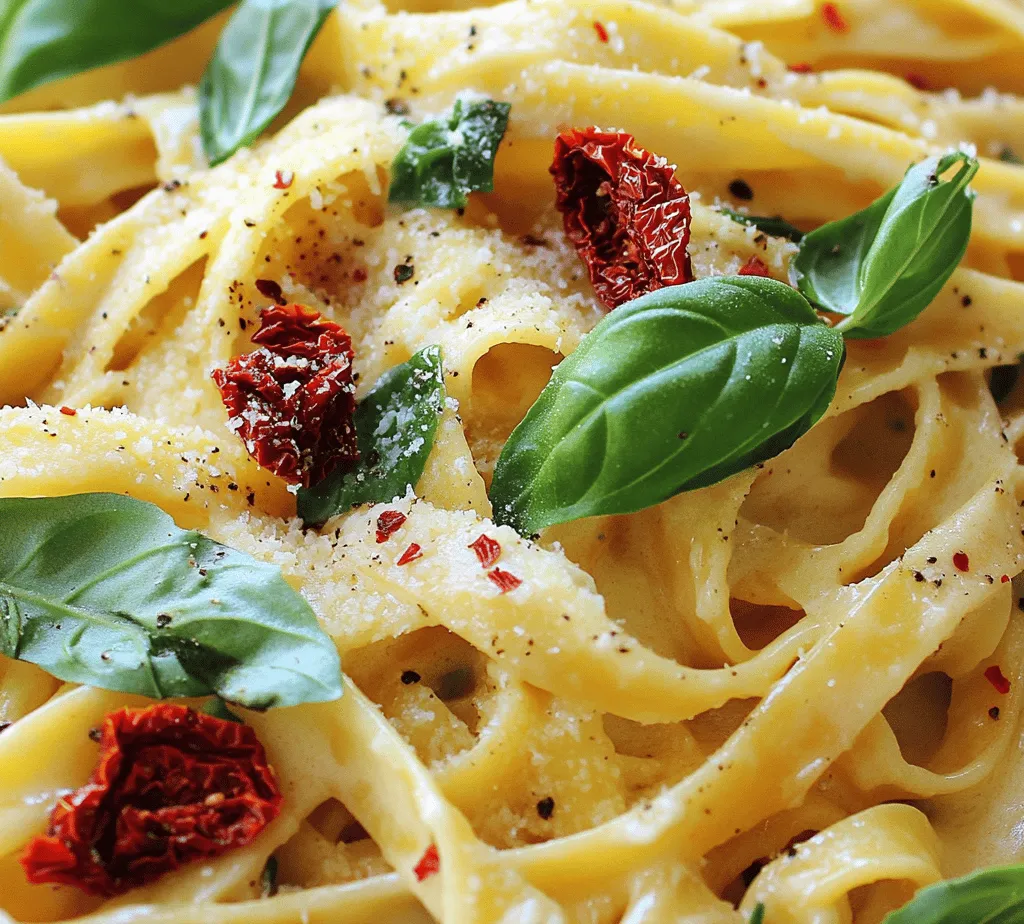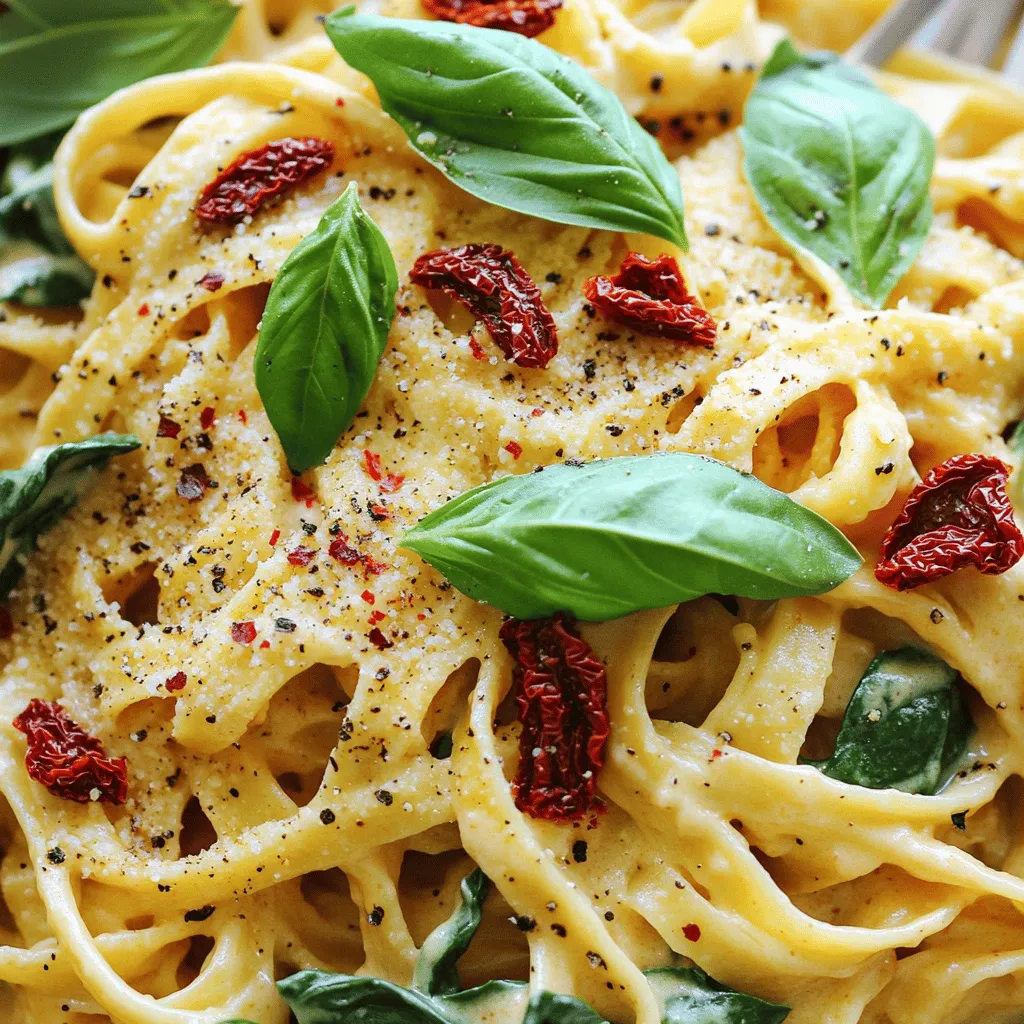Introduction
In the realm of comforting dishes, pasta always stands out as a beloved favorite. Whether it’s a quick weeknight meal or a special family gathering, pasta has an undeniable ability to bring people together over a deliciously satisfying plate. Among the myriad of pasta options, Cheesy Asiago Delight Pasta truly shines with its creamy texture and rich flavors. This dish combines the nutty, sharp taste of Asiago cheese with the savory goodness of garlic and sun-dried tomatoes, creating a decadent experience that tantalizes the taste buds.
Asiago cheese, known for its robust flavor and creamy melt, is the star of this dish. It elevates the pasta to new heights, creating a luxurious sauce that envelops each strand. The addition of garlic adds depth and aromatic allure, while sun-dried tomatoes bring a burst of umami and vibrant color. Whether you’re cooking for a cozy dinner at home or entertaining guests, this dish is sure to impress.
In this article, we will take a detailed look at how to prepare this delightful pasta dish, including insights into its ingredients, step-by-step cooking methods, and the culinary benefits of each component. Let’s embark on this culinary journey and discover what makes Cheesy Asiago Delight Pasta a standout recipe in any home chef’s repertoire.
Understanding the Ingredients
To truly appreciate the flavors in Cheesy Asiago Delight Pasta, it’s essential to understand the key components that come together to create this dish. Each ingredient plays a vital role, not only in flavor but also in texture and nutrition. Let’s delve into the foundational elements that make this pasta dish so special.
Benefits and Flavor Profiles of Fettuccine and Other Pasta Options
Fettuccine, a flat and thick pasta, is the perfect base for creamy sauces. Its shape allows it to hold onto the sauce beautifully, ensuring that each bite is filled with flavor. The texture of fettuccine complements the creaminess of the Asiago sauce, making it a popular choice in many Italian dishes. If you prefer, other pasta types like penne or rigatoni can also work well, but fettuccine remains the classic choice for this recipe.
Significance of Olive Oil in Cooking
Olive oil is a staple in Mediterranean cooking and serves several purposes in this dish. Not only does it enhance the flavor of the pasta, but it also acts as a base for sautéing garlic and sun-dried tomatoes. The richness of olive oil complements the sharpness of Asiago cheese, creating a harmonious balance in the final dish. Additionally, extra virgin olive oil is packed with healthy fats and antioxidants, making it a nutritious choice for cooking.
The Role of Garlic in Enhancing Flavor
Garlic is often considered the heart of Italian cuisine, and for good reason. Its strong, aromatic flavor elevates any dish it graces. In Cheesy Asiago Delight Pasta, garlic is sautéed to perfection, releasing its essential oils and creating a fragrant base for the sauce. The key is to sauté garlic just until it becomes fragrant, as overcooking can lead to a bitter taste. This careful balance allows garlic to enhance the overall flavor profile without overpowering the dish.
Heavy Cream: The Base for a Luxurious Sauce
Heavy cream is essential in creating the rich, creamy sauce that defines this pasta dish. It brings a velvety texture that envelops the fettuccine and allows the flavors of the Asiago cheese to shine through. The cream also helps to balance the sharpness of the cheese and the tanginess of the sun-dried tomatoes, creating a well-rounded sauce. When selecting heavy cream, opt for high-quality options without additives for the best flavor.
Asiago Cheese: A Deep Dive into Its Unique Characteristics
Asiago cheese is a semi-hard cheese originating from Italy, known for its nutty and slightly sharp flavor. It melts beautifully, making it an ideal choice for creamy sauces. Asiago comes in two varieties: fresh and aged. For this recipe, aged Asiago is recommended as it provides a stronger flavor and a more complex taste profile. Grating the cheese freshly will yield a more intense flavor and better melting properties than pre-grated options.
Sun-Dried Tomatoes: A Burst of Flavor and Nutrition
Sun-dried tomatoes are a fantastic addition to Cheesy Asiago Delight Pasta, bringing a sweet and tangy flavor that complements the richness of the cheese and cream. These tomatoes are packed with nutrients, including vitamins A and C, potassium, and antioxidants. Their concentrated flavor enhances the overall dish, adding depth and a pop of color. When using sun-dried tomatoes, consider whether you want to use oil-packed or dry-packed versions; oil-packed adds additional flavor and moisture, while dry-packed requires rehydration.
Baby Spinach: Adding Freshness and Vital Nutrients
Incorporating baby spinach into the dish not only adds a vibrant color but also infuses the pasta with essential nutrients, including iron, calcium, and vitamins A and C. The slight bitterness of spinach balances the richness of the cheese and cream, making it a wholesome addition. Baby spinach wilts quickly, allowing it to blend seamlessly into the pasta without compromising the overall texture.
Understanding Crushed Red Pepper Flakes: A Touch of Heat
For those who like a hint of spice, crushed red pepper flakes can be added to the dish. This ingredient introduces a mild heat that elevates the flavor profile without overwhelming the palate. The heat from the red pepper flakes contrasts beautifully with the creamy sauce and can be adjusted based on personal preference. A little goes a long way, so start with a small amount and increase as desired.
The Importance of Seasoning: Salt and Black Pepper
Proper seasoning is crucial in any recipe, and Cheesy Asiago Delight Pasta is no exception. Salt enhances the natural flavors of each ingredient, while freshly cracked black pepper adds another layer of depth. Seasoning will need to be adjusted throughout the cooking process, particularly when cooking the pasta and sautéing the garlic and spinach. Tasting as you go is key to achieving a perfectly balanced dish.
Cooking Preparation and Techniques
Now that we have a clear understanding of the ingredients, it’s time to prepare your kitchen and gather the necessary tools for crafting Cheesy Asiago Delight Pasta. The right preparation can make all the difference in the cooking process, ensuring everything goes smoothly.
Preparing Your Kitchen and Ingredients for Success
Start by organizing your kitchen space to ensure that you have easy access to all your ingredients and tools. Clear your countertops and gather everything needed for the recipe: fettuccine, Asiago cheese, garlic, sun-dried tomatoes, baby spinach, olive oil, heavy cream, and seasoning. Preparing all ingredients beforehand, including chopping garlic and grating cheese, will streamline the cooking process and help prevent any last-minute scrambling.
Essential Kitchen Tools and Utensils for Pasta Preparation
To successfully make Cheesy Asiago Delight Pasta, you’ll need a few essential kitchen tools:
1. Large Pot: For boiling the pasta.
2. Colander: To drain the cooked pasta.
3. Large Skillet or Pan: For sautéing the ingredients and combining the pasta with the sauce.
4. Wooden Spoon or Spatula: For mixing and tossing the pasta with the sauce.
5. Box Grater or Food Processor: To grate the Asiago cheese efficiently.
6. Measuring Cups and Spoons: For accurate ingredient measurements.
With these tools at hand, you’ll be well-prepared to create a delicious pasta dish.
How to Properly Cook Fettuccine: Tips for Perfect Al Dente
Cooking fettuccine to al dente perfection is key to achieving the best texture in Cheesy Asiago Delight Pasta. Start by bringing a large pot of salted water to a rolling boil. The salt not only adds flavor to the pasta but also enhances its overall taste. Add the fettuccine and stir occasionally to prevent it from sticking. Refer to the package instructions for cooking time, usually around 8-10 minutes. Taste the pasta a minute or two before the suggested cooking time to check for doneness. It should be tender yet firm to the bite—this is al dente.
Once cooked, reserve a cup of pasta water before draining the fettuccine in a colander. This starchy water can be used later to adjust the consistency of the sauce if needed.
The Art of Sautéing: Achieving the Perfect Garlic Aroma
Sautéing garlic is an art that requires attention and timing. After cooking the fettuccine, heat a generous amount of olive oil in a large skillet over medium heat. Once the oil is warm, add minced garlic and sauté for 30 seconds to 1 minute until fragrant. Be careful not to let the garlic brown too much, as it can turn bitter. The goal is to infuse the oil with garlic flavor while keeping it aromatic and mellow.
Adding sun-dried tomatoes at this stage will help release their flavors into the oil, creating a flavorful base for the sauce.
Creating a Cream Sauce: Techniques for a Smooth Consistency
With the garlic and sun-dried tomatoes sautéed, it’s time to create the creamy sauce. Reduce the heat to low and pour in the heavy cream, stirring gently to combine. Allow the cream to warm up without boiling; this will help achieve a smooth consistency. As the cream heats, gradually add grated Asiago cheese, stirring continuously until the cheese melts and integrates into the sauce. For a silkier texture, you can add reserved pasta water a little at a time, whisking until the desired consistency is reached.
Incorporating Cheese and Vegetables: Balancing Flavors and Textures
Once the cheese has melted and the sauce is smooth, it’s time to incorporate the baby spinach. Add the spinach to the skillet, gently folding it into the sauce until it wilts. This step not only adds nutrition but also creates a beautiful contrast of colors. Ensure that the spinach is evenly distributed throughout the sauce for a balanced flavor in every bite. Taste the sauce and season with salt and freshly cracked black pepper as needed.
Tossing Pasta: Ensuring Even Coating with Sauce
Finally, it’s time to add the cooked fettuccine to the creamy sauce. Using tongs or a pasta fork, gently toss the pasta in the sauce, ensuring that every strand is coated beautifully. If the sauce seems too thick, add more reserved pasta water until you achieve the desired consistency. This step is crucial for ensuring that the flavors meld well and that the pasta is evenly coated without clumping.
Garnishing for Presentation: The Role of Fresh Basil
While not included in the main ingredients, a sprinkle of fresh basil can elevate the dish’s presentation and flavor. Chiffonade fresh basil leaves and scatter them over the pasta before serving. The aromatic freshness of basil provides a delightful contrast to the rich, cheesy sauce and adds a pop of color to your plate.
With these steps laid out, you’re well on your way to creating a delicious plate of Cheesy Asiago Delight Pasta. In the next section, we will delve into the detailed step-by-step cooking instructions, guiding you through every nuance of this delightful recipe.




